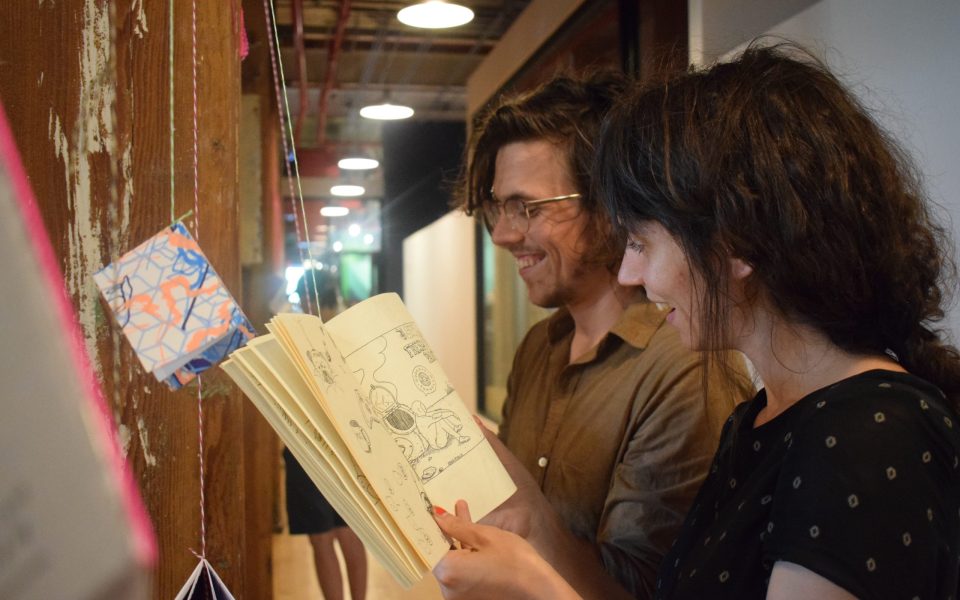The high-ceilinged hallways of an old textile mill — a relic of Greensboro’s industrial past — simultaneously buzzed with chatter about seizing the means of production and basked in quiet contemplation as established and soon-to-be zinesters and fans from across the state gathered in Revolution Mill on Sunday afternoon for the city’s second ’Zine (pronounced “zeen”) Fest.
Before event-goers entered a large, bustling room where ’zine-makers, comic artists, writers and other creatives supervised tables with their works, they walked through a long corridor decorated with an enchanting “library” of ’zines suspended in mid-air from strings.
Circulating the space, attendees viewed everything from Atiya Batts’ feminine yet horror-inspired surrealist prints of young women and the cat-filled, personal comics of couple Caroline Smith and Scott Hensell of Monk and Monstieur Comics.
John Neal, a local bookseller, sponsored materials for workshops like Piedmont Print Co-op’s printmaking class and “How-to-Zine” with Tristin Miller, the festival’s organizer. Two pristine glass walls enclosed open-concept meeting spaces where attendees like Nick Hatcher and Rebecca Silber made their first forays into the art of ’zine-making.
On the road from their hometown Raleigh to Greensboro, Hatcher and Silber resolved to co-found a ’zine; they’ll call it “Genuinely Messy.” Silber, who studies art history at Goucher College in Baltimore, makes a habit of observing people as they observe art. She said she’s drawn to the craft because, unlike paintings in a museum, “the way people interact with ’zines is far more personal…[and they’re] an interesting, mobile and cheaply-produced way for art to be translated to our everyday environment.”
“Anything DIY is really powerful,” Silber continued. “To be able to make things in-and-of yourself and not having to rely so much on buying things” is also a political act, she said.
’Zines are somewhat novel to Hatcher but he said the politics of the form captured his interest.
“My understanding is ’zines are initially created as mini-magazines that aren’t printable or sellable mainstream, and because of that they lend to alternative politics,” Hatcher said. “Capital is largely removed from the equation, so that removes a lot of power structures that exist in the normal printing and publishing industry.”
Mary O. — who declined to give her full name — shares Hatcher’s ideological motivation. She curates ’zines with anarchist and anti-authoritarian perspectives as a co-owner of Firestorm Books, a cooperatively-owned radical bookstore in Asheville.
“Historically, the means of producing and promoting media was often in the hands of the few and the powerful,” Mary O. said. “Once copy machines and the internet became disseminated in the public, it became decentralized… and now the many have the means to produce things. Since it’s a DIY movement, ’zines are an amazing way for anyone who has the ability to speak or write to get their words in front of people.”
Gerald Ward, who is self-taught, showcased that accessibility during two bookbinding workshops: one introducing three- and five-hole pamphlet stich-binding and the other on four-hole Japanese stab-binding. The process requires only a few small materials: paper, cover stock, an awl, scissors, a blunt needle, thread, two binder clips and a bone folder. Ward took to the craft as a therapeutic outlet for PTSD after returning from a tour of duty.
Artists with the Durham Artists Movement — a liberation-focused art collective that centers marginalized artists — understand the link between ’zine-making and healing. Rahima Rahi explained that Art Asylum is the collective’s art-filled project that provides an alternative process for those struggling with mental illness to create advance directives concerning how they would like to be cared for in the event of a crisis. The toolkit takes the basic form of a ’zine but necessitates more collaboration with its owner than most.
“Creating these directives needs to be something that people struggling with mental health feel supported in the process of creating,” Rahi said. “Even when talking about things that are difficult for us, we can be creative…[and] artists struggle a lot in the world than we live in. We didn’t know any other way to create this but to include our art.”
Art Asylum perhaps captures one of the event’s major takeaways: that ’zines are an inherently intimate form of art, concurrently personal and communal and that just when it seems our perspectives are nowhere to be found, we might stumble upon pocket-sized assurances that we aren’t alone.
Join the First Amendment Society, a membership that goes directly to funding TCB‘s newsroom.
We believe that reporting can save the world.
The TCB First Amendment Society recognizes the vital role of a free, unfettered press with a bundling of local experiences designed to build community, and unique engagements with our newsroom that will help you understand, and shape, local journalism’s critical role in uplifting the people in our cities.
All revenue goes directly into the newsroom as reporters’ salaries and freelance commissions.





Leave a Reply